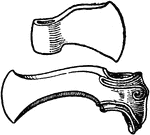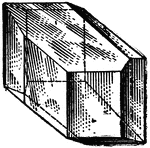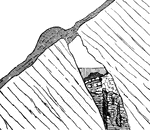Clipart tagged: ‘copper’

Mechanical Drawing Cross Hatching of Babbitt
A conventional cross hatching symbol for Babbitt, metal composed of tin and copper.

Galvanic Battery
"If we take for example, a slip of zinc, and another of copper, and place the in a cup of diluted sulphuric…
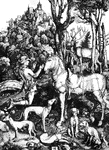
The Conversion of St. Eustace
"The Conversion of St. Eustace. By Albrecht Dürer. From the engraving on copper." -Heath, 1901
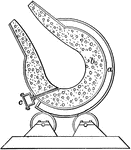
Converter Furnace
"Matte is converted into blister copper by means of a process called Bessemerizing, in a furnace called…
Copper Gilt
"Monstrance of Copper Gilt; Italian work of the 15th century." —The Encyclopedia Britannica, 1903

Copper Silicate Showing Rhombohedral Tetartohedrism In the Hexagonal System
This is a crystal of Copper Silicate (Dioptase) with a rhombohedron of the third order, (s), in combination…
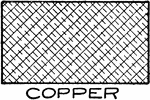
Mechanical Drawing Cross Hatching of Copper
Conventional cross hatching mechanical drawing of copper.

Early Roman Bar Money
"A bar of copper marked with the figure of a bull. Dates from the fourth century B.C."—Webster,…

Edison-Lalande Cell
"...is constructed with a plate of black oxide of copper suspended between two plates of zinc, and the…

Electrical Helix
"A copper wire coiled, by winding it around a piece of wood. The turns of the wire should be close together…

Expansion of Solids
"The expansion of solids by heat is clearly shown by the following experiment: m represents a ring of…

Obverse and Reverse Sides of a Gazzetta
"Gazzetta of the Ionian islands, 1801. A small copper coin, worth about 3 farthings, made in Venice…
Gold Plate
"It is of gold plate, so thick as to require no "piping" at the back to sustain it; but in general the…

Difference of Heat Transference Between Copper and Iron
"Place a bar of iron and a similar one of copper end to end so as to be heated equally by the flame…

Old Persian Jar
This old Persian jar is made with a repousse copper technique. It is a metalworking technique shaped…

Lenz's Law
"Experiment illustrating Lenz's Law. If a copper ring be held in front of an ordinary elecromagnet,…

Magnet
"The coils of wire may begin near one pole of the magnet and terminate near the other, or the wire may…
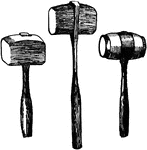
Mallets
A mallet is a type of hammer with a head made of softer materials than the steel normally used in hammerheads,…

Kelvin Flexible Metallic Ligament
"To make the ligament, a very large number of exceedingly fine copper wirers laid close together are…
Nitrogen Preparation
"The bottle (a) serves as an aspirator to draw airthrough the apparatus and also to collect the residual…
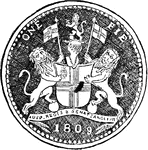
Pie
The smallest Anglo–Indian copper coin, equal to one third of a pice. About one fourth of a United…

Pie
The smallest Anglo&mdashIndian copper coin, equal to one third of a pice. About one fourth of a United…

Copper-Plate Printing
"In all engraving upon metal plates the traces or marks which are to appear on the paper are cut or…
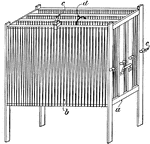
Rheostat
"Nichols Rheostat. a, wooden frame; b, tinned iron strip; c, stationary, and c', movable binding-posts;…

Short Cartridge - Copper Case
"A cartridge containing shot instead of a bullet, and intended to serve various purposes. a, copper…
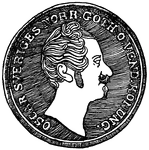
Skilling Coin - Obverse
"A money formerly used in Scandinavia and northern Germany, in some places as a coin and in others as…

Skilling Coin - Reverse
"A money formerly used in Scandinavia and northern Germany, in some places as a coin and in others as…
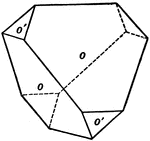
Sphenoidal Crystallization
An example of sphenoidal crystallization is Iron-Copper-Sulfide (FeS_2_Cu), also known as chalcopyrite.
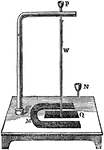
Wire Vibration
"Vibration of a wire. A conducting copper wire, w, is suspended by a loop from a hook of the same metal,…
